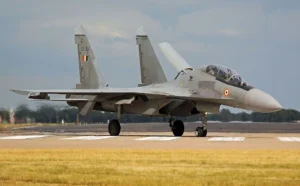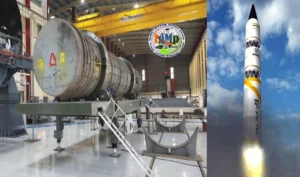The rocketing numbers
A few days ago, Defence Minister Rajnath Singh congratulated all stakeholders on crossing a big milestone in defence exports: India’s defence exports have touched a record Rs 21,083 crore (approximately $2.63 Billion) in the financial year 2023-24, a growth of 32.5% over the last fiscal when the figure was Rs 15,920 crore. If the last decade is compared with the previous one, the growth picture gets more dramatic — defence exports have grown by 21 times in the last decade, from Rs 4,312 crore during 2004-05 to 2013-14 to Rs 88,319 crore
from 2014-15 to 2023-24. This explosive growth is fuelled by a strong indigenisation push by the government aimed at achieving self-reliance in defence when India seeks a bigger strategic role for itself in the world even as it races to become the world’s third-largest economy. The rapid growth in defence manufacturing and exports have powered many PSU defence stocks to new highs.

Though the private sector has led the growth, defence PSUs too have made significant contributions. The private sector and the PSUs have contributed about 60% and 40% respectively.
In addition, there has been a rise in the number of export authorisations issued to the defence exporters during 2023-24. From 1,414 export authorisations in 2022-23, the number jumped to 1,507 in 2023-24.Making Indian military atmanirbharIndia is building a gargantuan defence-industrial complex, which includes large corporates such as L&T, Godrej and Adani to PSUs, startups and research bodies, and manufactures from ballistic missiles such as BrahMos and fighter jets to artillery shells and night-vision devices.
Achieving self-reliance in defence and reducing import dependency for military hardware is important for India to maintain its strategic autonomy. Imagine a country which is dependent on others for even its basic defence needs such high-latitude clothing. The Russia-Ukraine war, which saw western countries scramble to produce weapons to supply them to Ukraine and Russia unable to procure its military supplies from other countries, has underlined the need for self-reliance in defence systems. For India, which is now flexing its diplomatic muscles at the international stage to pursue an assertive foreign policy, defence indigenisation is all the more important. That’s what Prime Minister Narendra Modi’s Atmanirbhar project has set out to achieve.
India is lowering its dependence on foreign suppliers through a mix of policy initiatives that tap into design and manufacturing capabilities of public enterprises, large business conglomerates and even startups. Two major policy initiatives are the notification of positive indigenisation lists and earmarking 75% of the capital acquisition budget for procurement from local companies. The government has given approval to nearly 45 companies/joint ventures operating in the defence sector with foreign OEMs (original equipment manufacturers), in addition to launching the Innovations for Defence Excellence (iDEX) scheme which aims to create an ecosystem which fosters innovation and encourages technology development in defence by engaging R&D institutes, academia, industries, start-ups and even individual innovators.
Out of 4,666 defence items, including assemblies, sub-assemblies, raw materials, critical spares and components, which were listed for indigenisation, 2,920 items have already been indigenised. 40 to 50 licences are issued every year in defence production.
Among the major defence items being exported, besides the big-ticket BrahMos missiles systems, are Dornier-228 aircraft, ALH helicopters, SU avionics, artillery guns, radars, armoured vehicles, rockets and launchers, torpedo loading mechanism, alarm monitoring & control systems, night-vision monocular and binocular, lightweight torpedo and fire-control systems, weapons-locating radar, HF radio, Kavach MOD, drones, artillery systems and explosives, and coastal surveillance radars.
Gunning for growth
The government aims to nearly triple India’s total annual defence production to Rs 3 lakh crore by 2028-29. The target for defence exports is more than double at Rs 50,000 crore as against Rs 21,083 crore at present. The target for 2024-25 is Rs 1,75,000 crore worth of total annual defence production, which would include exports worth ₹35,000 crore.
India has been in overdrive to sell its indigenously built light-combat aircraft Tejas, manufactured by state-owned Hindustan Aeronautics Limited (HAL), but has failed to find a customer so far. This one item can lift India’s exports to a very high level and put India into an exclusive club of countries that export fighter jets. The frantic search for Tejas customers continues as India tries to boost its defence exports and build relations with many countries in order to consolidate the Global South. A few days ago, India delivered HAL-228 aircraft to the defence forces of Guyana.
Rajnath Singh has said at the Times Now Summit recently that India is looking to export fighter jet engines in the future. He referred to the engine manufacturing agreement between GE Aerospace and Hindustan Aeronautics for the GE 414 engine that will power future variants of the Tejas.
According to a report by brokerage house Jefferies India, with an estimated domestic defence opportunity ranging between $100-1$20 billion over the next five-six years, the sector anticipates a visible 13 per cent industry Compound Annual Growth Rate (CAGR) from FY23 to FY30. The export defence opportunities are projected to witness a commendable 21 per cent CAGR from FY23 to FY30.
Moreover, the Indian government’s concerted efforts to bolster country-to-country relations aimed at promoting exports add another layer of buoyancy to the sector’s prospects. Jefferies anticipates further upside in stocks like Hindustan Aeronautics (HAL), Data Patterns and Bharat Electronics (BEL).
Despite these projections, certain risks loom over the sector, including technology obsolescence and management bandwidth constraints, aid the report. However, with prudent strategies and robust government support, India’s defence sector appears poised for exponential growth, driving both economic and strategic advancements.








